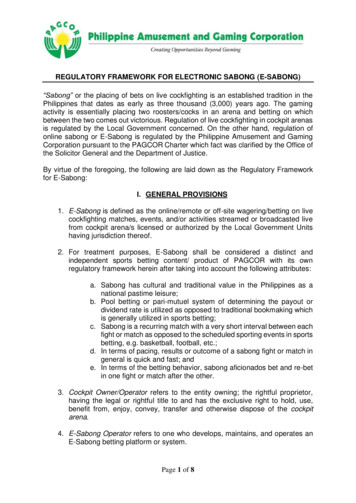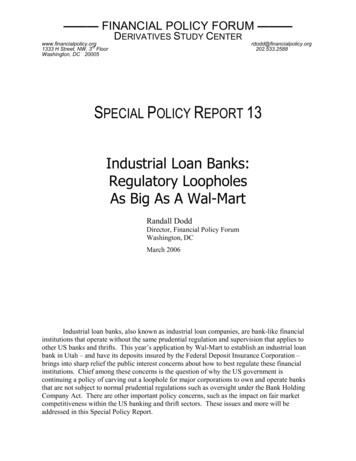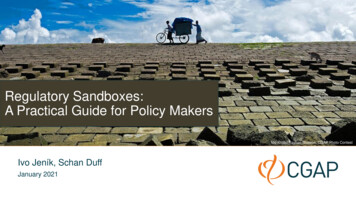
Transcription
Regulatory Sandboxes:GUIDE:A TECHNICALPractical Guidefor Policy MakersHow to Build a Regulatory SandboxMd Khalid Rayhan Shawon, CGAP Photo ContestIvo Jeník, Schan DuffJanuary 2021
Table of ContentsSection 1IntroductionSection 2Deciding for a regulatory sandboxSection 3Designing the right regulatory sandboxSection 4Running a successful regulatory sandboxSection 5Alternatives & complementsSection 6Sandbox simulationSection 7Conclusion22
Sujan Sarkar, CGAP Photo ContestSection 1: Introduction
“A regulatory sandbox is a tool for developing evidence about how anew product, technology, or business model (innovation) works andthe outcomes it produces. Evidence gathering can help assuage (orconfirm) regulatory concerns about the impact of innovations,allowing beneficial innovations to reach the marketplace.”CGAP Technical Guide: How to Build a Regulatory Sandbox (2020)
What is a regulatory sandbox?A formal regulatory initiative: to test innovationin the live marketplaceon a time- and scope-limited basisto determine the appropriate regulatory treatment/statusbefore the innovation can fully operate in the marketplace where other options fall short 5
How are regulatory sandboxes used?Technology TestedParticipantsby SectorAI 2%Blockchain& Crypto25%Other31%Advice7%Asset Management7%Wholesale %Digital ID11% Equity crowdfundingEXAMPLES Blockchain-based payments Robo advisorsPayments31% Alternative credit scoring Automated savings Personal finance managementSource: CGAP analysis (2019)6
Benefits and risks of a regulatory sandboxBenefitsRisksLowers cost of innovation in somecasesCompetition issues (regulators pickwinners, create uneven playing field)Opens access to regulatorLimited capacity of regulator to runsandboxCreates formal framework for safe,live testingLiability issues in case of failedtestingAllows for market monitoringUnclear pathways for successful exitSignals openness to innovationIntra- & inter-agency coordinationissuesLimited regulatory tools to implementsandboxFor more information, see CGAP Working Paper.7
Want to learn more at your own pace?Visit CGAP’s Collection of resources:www.cgap.org/Sandbox Technical Guide: How to Build aRegulatory Sandbox Working Paper: Regulatory Sandboxesand Financial Inclusion Interactive map of sandbox firms Global repository of sandbox policydocuments Blog post series8
Photographer Name, CGAP Photo ContestUdit Roy, CGAP Photo ContestSection 2: Deciding if a sandbox is theright tool
CGAP Tip“If you do not need to test the innovation in the live marketplace toidentify and/or effect a regulatory change, you most likely do notneed a regulatory sandbox.”Ivo Jeník (CGAP)
A 3-step process to decide if you need a sandboxStep 1: DefineobjectivesStep 2: IdentifybarriersStep 3: Assesssolutions11
Step 1: Define your objectivesRegulators frequently citethree overarching reasons touse a sandbox:1. Promote innovation and/orcompetition2. Address regulatorybarriers to innovation3. Learn about developmentsin the marketplaceBut is a sandbox really theright tool to achieve allthese objectives?For more information, see CGAP Technical Guide.12
Step 1: Why it’s important to start with objectives Defining objectives upfront iskey Objectives help regulatorsselect the right tool(s)maybe Objective setting is driven byregulators’ needs and limitedby specific circumstances(threshold constraints - seeSection 3) Objectives help defineexpected outcomes andimpact13
Defining objectives: An example“[T]he Sandbox is intended to foster responsibleinnovation that benefits consumers in Sierra Leone byimproving the quality of, and access to, financial productsand services.”From the Bank of Sierra Leone in the Regulatory Sandbox Pilot Program Guidelines and ApplicationForm (April 2018). See http://www.bsl.gov.sl/BSL Sandbox Program.html.For more examples, see CGAP Technical Guide.
Step 2: Identify the barriers to innovationA sandbox can address some types of barriersA sandbox can help addressregulatory barriers such as:1. Costly compliance2. Regulatory uncertainty3. Prohibitive regulationBut a sandbox only makessense when those barrierscannot be addressedwithout live testing.For more information, see CGAP Technical Guide.15
Step 2: Identify the barriers to innovationNot all barriers require a sandbox Regulation is often cited as abarrier to innovation Not every innovation shouldreach the marketplace Barriers to good innovationshould be lifted To lift the barriers, regulatorscan choose from a portfolio oftoolsSandbox is only suitable whenlive testing is needed.16
Step 3: Assess (alternative) solutionsThere are several regulatory tools thatmay be more suitable than asandbox:1. Other innovation facilitators (e.g.,Innovation Office)2. Adopting a change of rules3. Granting exemptions4. For more options see Section 5Some of these tools can be usedinstead of a sandbox, some shouldbe used instead of it, and somealong with a sandbox.For more information, see CGAP Technical Guide.17
Country example: Thailand18
Photographer Name, CGAP Photo ContestKyaw Winn, 2017 CGAP Photo ContestSection 3: How to design the sandboxyou need
Key design elements of a regulatory sandbox There are five elements that are typically included in sandbox design:1. Eligibility2. Governance3. Timing4. Test restrictions5. Exit options Each element entails making choices that together determine the sandboxdesign The elements should reflect ‘threshold constraints’, which consist of the legalframework, market conditions, and capacity within the local jurisdiction.20
A closer look at these five sandbox design elements21
Matching design elements with constraints: Legal frameworkStatutory mandate Regulator authorized to establish a sandbox (Capital Markets Authority of Kenya) A legislative change needed (Colombia, Lithuania, Mexico, Poland, Spain) Sandbox justified as a permissible extension of discretionEligibility criteria Licensed or otherwise formally authorized entities (Hong Kong MonetaryAuthority) Entities outside the regulatory framework (PolicyPal in Singapore, Pezesha inKenya) Nonfinancial services providers (RegTech)Testing restrictions Compliance with legally mandated restrictions and requirements that fall outsidea regulator’s discretion (minimum AML/CFT) Measures to address potential consumer risks even when relaxation possibleExit options License granted (FCA UK sandbox graduates) Other permission to operate in the marketplace granted (Upstart in the US). Regulatory change implemented (Pezesha in Kenya)22
Matching design elements with constraints: Marketconditions/capacityDemand refers to the demand from innovators for a regulatory sandbox.Capacity refers to the capacity of the regulator to implement a regulatory sandbox.For more information, see CGAP Technical Guide.23
Photographer Name, CGAP Photo ContestKailash Mittal, CGAP Photo ContestSection 4: How to run a sandboxsuccessfully
Secret sauce for a successful sandboxThere are four ingredients for success:1. Appropriate design (see Section 3)2. Well-defined governance and processes3. Sufficient capacity and resources4. Strong stakeholder buy-in25
How to manage governance, process, capacity, and buy-inKey steps to follow to ensure that a sandbox runs well: Define who owns the sandbox and who runs it Line up internal support Allocate sufficient resources Outline the internal process Ensure coordination with external stakeholders Establish formal and informal support channels Run external and internal stakeholder consultationsSee templates for sandbox teams in CGAP Technical Guide.26
Internal process: Testing and exit A testing plan outlines what is being tested, how it is beingtested and the expected outcomes Testing plans are typically proposed by applicants andapproved by the regulator on a case-by-case basis A testing plan should: Taiwan’s FSC Testing PlanDefine the overall timeline and budgetIdentify precisely what is being tested, how and whyDefine milestones and success criteriaDefine risks and mitigating measuresIdentify staff and their responsibilitiesEstablish rules for engaging with and reporting to the regulatorthroughout the testing periodSee the example of the Taiwan Financial SupervisoryCommittee (FSC)For more information, see CGAP Technical Guide.27
Exit scenarios: How a firm leaves the sandbox The regulator should map its own regulatory frameworkagainst each of the possible outcomes and avoidsetting up a sandbox without having legal clarity oneach of the potential exit options Final evaluation is based on regular reports deliveredthroughout the testing phase and the final report (by thesandbox participant, as in Kenya, or an independentauditor, as in Bahrain)For more information, see CGAP Technical Guide.28
Examples of exit scenarios: UK, Kenya, Brazil29
Ramon Castillo, CGAP Photo ContestSection 5: What are alternatives to asandbox?
A sandbox is not the only optionThere are several options thatregulators can pursue inresponse to innovation. Forexample: Other innovation facilitatorssuch as an Innovation Office,Innovation Hub or Accelerator A rule or policy update Other regulatory tools such aswait-and-see, test-and-learn orexemptions31
Alternatives & complements (1)DescriptionWhen applicableThe regulator monitors anEarly-stage innovation whereinnovation before deciding on a the level of regulatoryregulatory treatment.uncertainty is too high to beovercome through a limited liveWait-and-see/testing.In case of forbearance, theForbearanceregulator decides to toleratecertain behavior in the marketotherwise deemed noncompliant.The regulator defines an ad hoc A specific financial innovation isframework for safeguarded live potentially beneficial andTest-and-learn testing of a specific innovation. market-worthy but the regulatorneeds more information toresolve uncertainty.ExamplesP2P lending in China(early stages)Cryptocurrencies aroundthe world (early stages)Mobile money in Kenya,Philippines, Tanzania32
Alternatives & complements (2)DescriptionThe regulator sets a structuredand formal framework forInnovationregular engagement with theOffice / Hubindustry on innovation (withoutlive testing).Regulatory The regulator initiates achangelegislative change, adopts newregulation or amends theexisting one, or re-considersinterpretation and application ofthe existing rules.New License A special instance of theregulatory change – a newlicensing regime for innovativebusinesses engaged in certainactivities.When applicableThe regulator identifies areasonable demand forregulatory consultation andguidance from innovators.ExamplesFrance, Uganda, UKThe regulator has identifiedgaps or inconsistencies in thelegal and regulatory frameworkor has deemed changedcircumstance requiring achange in the existing rules.The regulator has identifiedareas of particular interest toinnovators where licensingrequirements can be definedwithout the need to evaluatethem on a case-by-case basis.Remote customeridentification in MalaysiaAustralia, Colombia,SwitzerlandFor more information, see CGAP Technical Guide.33
Country example: Taiwan’s innovative ecosystemInitiatives established by the Financial Supervisory Commission (FSC) to supportinnovation in the financial sector: Business trial: a licensed financial institution may apply for a business trial if it seeks toexpand its approved business in innovative technological ways. Fintech Space: an incubator and accelerator for fintech startups. Crowdfunding platforms: the Taipei Exchange set up the equity-based “Go IncubationBoard for Startup and Acceleration Firms” to help startups raise capital. Consultation points: the FSC also established consultation points such as the InnovationCenter and the “Regulatory Clinic” in the FintechSpace to help startups resolve questionsabout financial regulations. Task forces: the FSC directed the financial industry associations to set up taskforces to dealwith innovative businesses, fintech general issues, open banking, e-payment, blockchain, androbo-advisors.For more information, see CGAP Technical Guide.34
Photographer Name, CGAP Photo ContestKlienne Eco, CGAP Photo ContestSection 6: Sandbox simulation
How to use a sandbox simulation to build capacity Sandbox simulation is a way for regulators in a half-day workshop to quicklytest the need for a sandbox and the proposed framework The sandbox simulation helps answer the following questions:ooooooooDo I need a sandbox?Will a sandbox help to solve any specific issue I face?What would such a sandbox look like?Who needs to be involved in setting up the sandbox?Does the proposed sandbox work as intended, or should it be modified?Are all sandbox processes correctly defined?Do we have enough capacity to implement the sandbox?Does the sandbox cover all possible scenarios?For more information, see CGAP Technical Guide.36
Four steps in a sandbox simulationStep 1:1. Draft casestudies Identify real or realistic examples of tech-enabled financial innovation at thefringes of the current legal and regulatory framework (e.g., fintech companiesoperating in other markets or companies that have approached you with theirinnovative idea) (TIP: use your sandbox application forms) The simulation can be organized as a half-day workshop with the sandboxteam and other experts needed for successful sandbox implementation (e.g.,Step 2:legal and regulatory, licensing, supervision experts)Organize thesimulationStep 3:Run thesimulationStep 4:Evaluate andtweak Present the case studies to the participants, and ask them to treat them as ifthe sandbox was/was not in place Use the simulation results to draft and/or adapt the sandbox framework37
Step 1: Draft case studies Draft a series ofapplications (someeli
Section 6 Sandbox simulation Section 7 Conclusion. Section 1: Introduction Sujan Sarkar, CGAP Photo Contest . CGAP Technical Guide: How to Build a Regulatory Sandbox (2020) “A regulatory sandbox is a tool for developing evidence about how a new product, technology, or business model (innovation) works and the outcomes it produces. Evidence gathering can help assuage (or confirm) regulatory .

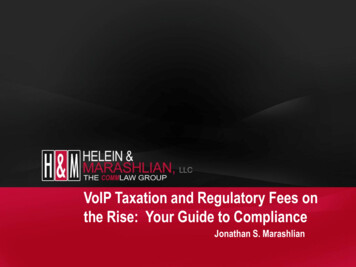
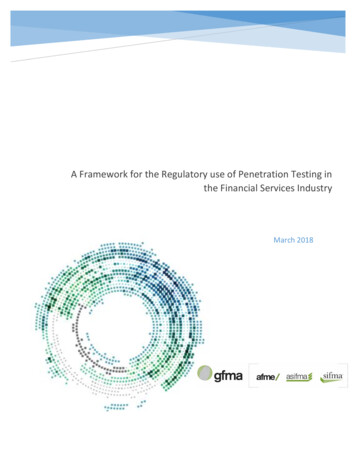
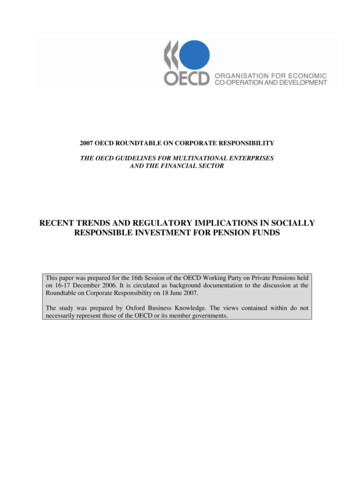
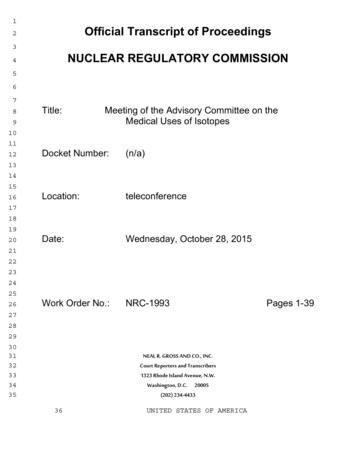

![Financial Services Regulatory Reform (00C) [Read-Only]](/img/2/2018-03-29-davis-polk-financial-services-regulatory-reform-tool-march-2018.jpg)
